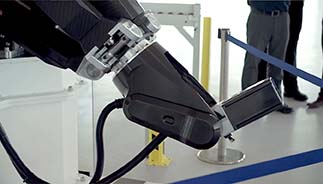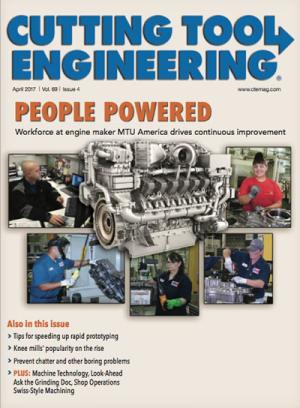Stiffness is a must in precision machining. Traditional machine tools depend on massive structures and large beds and footprints to enhance stiffness. But the massiveness that ensures predicable stiffness all the way to the end of the cutting tool also ensures that the machine itself isn’t easily moved. For example, a 5-axis machine able to drill accurate 50mm (1.97") holes in titanium could weigh as much as 20 tons (18,184 kg) and have a 3-sq.-m (9.84-sq.-ft.) footprint.
Robot arms used in assembly and other operations are much easier to move, but lack the necessary stiffness needed for precision machining. Robot arms and machine tools traditionally work as a series of serial links between the base and the end effector, which, in the latter’s case, is the cutting tool. The more links, the less stiffness.
The goal of parallel kinematics machines (PKMs), which have been in development since the mid-1990s, is to provide the stiffness necessary for highly precise machining without as much mass as conventional machines. PKMs have parallel rather than serial links between the base and the working end. The links that control the X-, Y- and Z-axis movements of the end effector aren’t connected serially, with one stacked on the other. Rather, they each have their own connection to the end effector, which allows improved stiffness with much less mass.

Three composite-constructed, parallel-sequenced arms are separately linked to the machining head of the XMini. Image courtesy of Exechon Enterprises.
(Imagine four acrobats standing on each other’s shoulders. The one at the bottom has to be strong, but no matter how strong he or she is, the acrobat at the top isn’t going to want to thread a needle up there. Now imagine three acrobats on the ground, working together to hold the fourth one up as if they were the legs of a stool. That’s a rough approximation of serial vs. parallel kinematics.)
Exechon Enterprises LLC, Abu Dhabi, United Arab Emirates, has introduced the XMini PKM, which merges the flexibility and high dynamics of an articulated-arm robot with the stiffness and accuracy of a rigid machine tool. The machine can apply 7-kN tool force, offers 3G acceleration and maintains a positioning accuracy of ±10µm. At the same time, it is made of carbon fiber and is modular. It can be broken into five modules, each of which is manageable to carry by one or two people, and be reassembled inside spaces traditionally hard to access by machines or people.
XMini is equipped with a flexible frame, XFrame, and frame-integration software, XFIS, which reportedly allow it to adapt to any existing jig or fixture. Exechon asserts that a factory can go from identifying a need to starting the XMini in 72 hours.
PKM pioneer Kalle Neumann, who designed the XMini, said Boeing and Airbus each approached him in 2012 for help in doubling their respective production capabilities by 2020 without doubling floor space and employee head count. The result was Exechon Enterprises LLC—a joint venture comprised of U.A.E.-based Injaz National, U.S.-based Lockheed Martin and Sweden-based Tecgrant AB—and the XMini.
“The paradigm shift is in taking the machine to the part instead of bringing the part to the machine,” Neumann stated.
For more information about Exechon Enterprises LLC, Negaunee, Mich., visit www.exechon.com or call (906) 458-0463.
Related Glossary Terms
- fixture
fixture
Device, often made in-house, that holds a specific workpiece. See jig; modular fixturing.
- jig
jig
Tooling usually considered to be a stationary apparatus. A jig assists in the assembly or manufacture of a part or device. It holds the workpiece while guiding the cutting tool with a bushing. A jig used in subassembly or final assembly might provide assembly aids such as alignments and adjustments. See fixture.
- parallel
parallel
Strip or block of precision-ground stock used to elevate a workpiece, while keeping it parallel to the worktable, to prevent cutter/table contact.
- precision machining ( precision measurement)
precision machining ( precision measurement)
Machining and measuring to exacting standards. Four basic considerations are: dimensions, or geometrical characteristics such as lengths, angles and diameters of which the sizes are numerically specified; limits, or the maximum and minimum sizes permissible for a specified dimension; tolerances, or the total permissible variations in size; and allowances, or the prescribed differences in dimensions between mating parts.
- stiffness
stiffness
1. Ability of a material or part to resist elastic deflection. 2. The rate of stress with respect to strain; the greater the stress required to produce a given strain, the stiffer the material is said to be. See dynamic stiffness; static stiffness.


